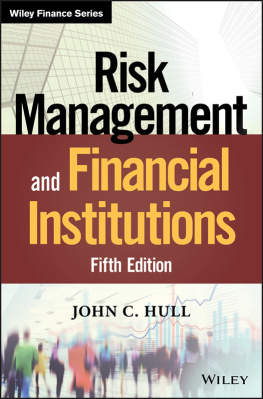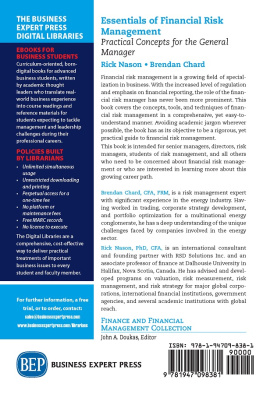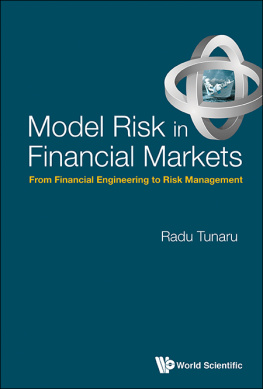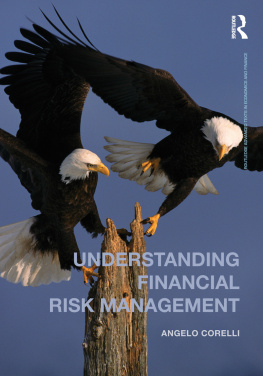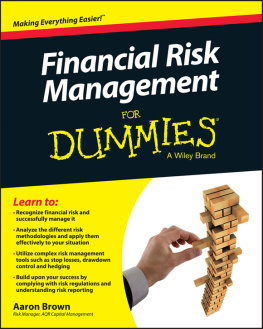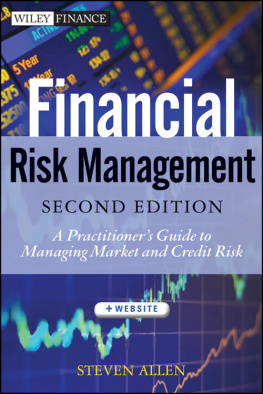
Founded in 1807, John Wiley & Sons is the oldest independent publishing company in the United States. With offices in North America, Europe, Australia, and Asia, Wiley is globally committed to developing and marketing print and electronic products and services for our customers' professional and personal knowledge and understanding.
The Wiley Finance series contains books written specifically for finance and investment professionals as well as sophisticated individual investors and their financial advisors. Book topics range from portfolio management to e-commerce, risk management, financial engineering, valuation and financial instrument analysis, as well as much more.
For a list of available titles, visit our Web site at www.WileyFinance.com.
Cover images: Roman Sigaev/Shutterstock;
Rawpixel.com/Shutterstock; Chalermsak/Shutterstock
Cover design: Wiley
Copyright 2018 by John C. Hull. All rights reserved.
Published by John Wiley & Sons, Inc., Hoboken, New Jersey.
The Third Edition was published by John Wiley & Sons, Inc., in 2012. The first and second editions of this book were published by Prentice Hall in 2006 and 2009, respectively.
Published simultaneously in Canada.
No part of this publication may be reproduced, stored in a retrieval system, or transmitted in any form or by any means, electronic, mechanical, photocopying, recording, scanning, or otherwise, except as permitted under Section 107 or 108 of the 1976 United States Copyright Act, without either the prior written permission of the Publisher, or authorization through payment of the appropriate per-copy fee to the Copyright Clearance Center, Inc., 222 Rosewood Drive, Danvers, MA 01923, (978) 750-8400, fax (978) 646-8600, or on the Web at www.copyright.com. Requests to the Publisher for permission should be addressed to the Permissions Department, John Wiley & Sons, Inc., 111 River Street, Hoboken, NJ 07030, (201) 748-6011, fax (201) 748-6008, or online at http://www.wiley.com/go/permissions.
Limit of Liability/Disclaimer of Warranty: While the publisher and author have used their best efforts in preparing this book, they make no representations or warranties with respect to the accuracy or completeness of the contents of this book and specifically disclaim any implied warranties of merchantability or fitness for a particular purpose. No warranty may be created or extended by sales representatives or written sales materials. The advice and strategies contained herein may not be suitable for your situation.You should consult with a professional where appropriate. Neither the publisher nor author shall be liable for any loss of profit or any other commercial damages, including but not limited to special, incidental, consequential, or other damages.
For general information on our other products and services or for technical support, please contact our Customer Care Department within the United States at (800) 762-2974, outside the United States at (317) 572-3993 or fax (317) 572-4002.
Wiley publishes in a variety of print and electronic formats and by print-on-demand. Some material included with standard print versions of this book may not be included in e-books or in print-on-demand. If this book refers to media such as a CD or DVD that is not included in the version you purchased, you may download this material at http://booksupport.wiley.com. For more information about Wiley products, visit www.wiley.com.
Library of Congress Cataloging-in-Publication Data:
Hull, John, 1946
Risk management and financial institutions / John C. Hull. Fifth Edition.
pages cm. (Wiley finance series)
Includes index.
ISBN 978-1-119-44811-2 (cloth); ISBN 978-1-119-44816-7 (ePDF);
ISBN 978-1-119-44809-9 (ePUB)
1. Risk management. 2. Financial institutionsManagement. I. Title.
HD61.H83 2015
332.10681dc23
2014037477
To Michelle, Peter, and David
Business Snapshots
1.1The Hidden Costs of Bankruptcy
2.1Googles IPO
2.2PeopleSofts Poison Pill
2.3How to Avoid Loan Losses
3.1Equitable Life
3.2A Perfect Storm
4.1Mutual Fund Returns Can Be Misleading
5.1The Unanticipated Delivery of a Futures Contract
5.2A Software Error?
5.3Microsofts Hedging
5.4Procter and Gambles Bizarre Deal
5.5SocGens Big Loss in 2008
6.1All BBBs Are Not the Same
6.2A Trading Opportunity?
8.1Hedging by Gold Mining Companies
8.2Dynamic Hedging in Practice
8.3Is Delta Hedging Easier or More Difficult for Exotics?
10.1What Causes Volatility?
10.2Making Money from Foreign Currency Options
12.1Historical Perspectives on VaR
15.1Systemic Risk
16.1Credit Suisses CoCo Bond Issues
17.1Rehypothecation
19.1The CDS Market
19.2Is a CDS a Flawed Contract?
19.3Contagion
22.1Long-Term Capital Managements Big Loss
22.2Traffic Light Options
23.1The Hammersmith and Fulham Story
23.2Rogue Trader Insurance
24.1Northern Rock
24.2Ashanti Goldfields
24.3Metallgesellschaft
24.4The Crash of 1987
25.1The London Whale
25.2Kidder Peabodys Embarrassing Mistake
25.3Exploiting the Weaknesses of a Competitors Model
26.1The EGT Fund
27.1Cross-Selling at Wells Fargo
27.2The Santander Rail Deal
27.3ABACUS
28.1Mt. Gox
28.2Eastman Kodak and the Digitization of Photography
29.1Big Losses
Preface
Risk management practices and the regulation of financial institutions have continued to evolve in the past three years. Risk Management and Financial Institutions has been expanded and updated to reflect this. Like my other popular text Options, Futures, and Other Derivatives, the book is designed to be suitable for practicing managers as well as university students. Those studying for FMA and PRM qualifications will also find the book useful.
The book is appropriate for university courses in either risk management or financial institutions. It is not necessary for students to take a course on options and futures markets prior to taking a course based on this book. But if they have taken such a course, some of the material in the first nine chapters does not need to be covered.
The level of mathematical sophistication and the way material is presented have been managed carefully so that the book is accessible to as wide an audience as possible. For example, when covering copulas in Chapter 11, I present the intuition followed by a detailed numerical example; when covering maximum likelihood methods in Chapter 10 and extreme value theory in Chapter 13, I provide numerical examples and enough details for readers to develop their own spreadsheets. I have also provided Excel spreadsheets for many applications on my website:
www-2.rotman.utoronto.ca/~hull
This is a book about risk management, so there is very little material on the valuation of derivatives.(That is the main focus of my other two books, Options, Futures, and Other Derivatives and Fundamentals of Futures and Options Markets.) The appendices at the end of the book include material that summarizes valuation and other results that are important in risk management. The RMFI Software (version 1.00) is designed for this book and can be downloaded from my website.
New Material
The fifth edition has been fully updated and contains much new material. In particular:
- A new chapter on financial innovation has been included (Chapter 28).
- A new chapter on the regulation of OTC derivatives markets has been included (Chapter 17). This covers both cleared and uncleared transactions and explains the Standard Initial Margin Model (SIMM).
Next page
